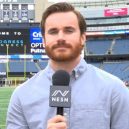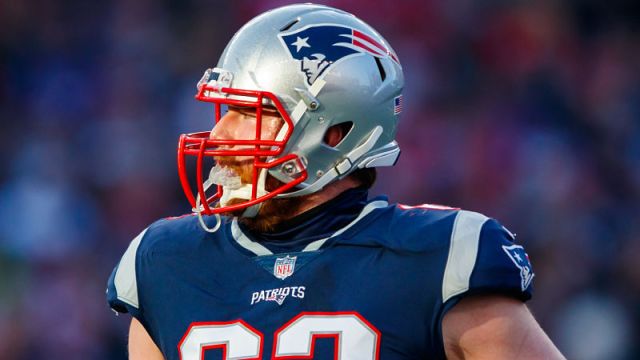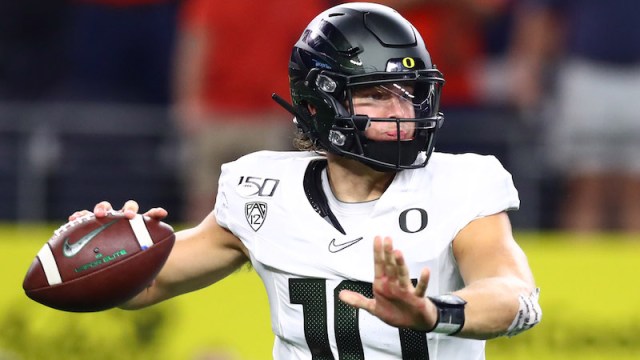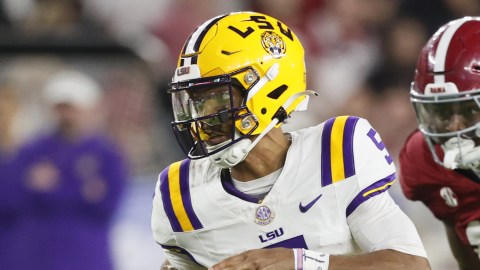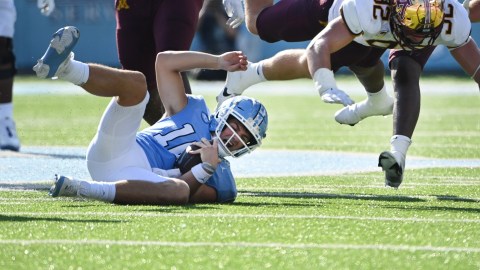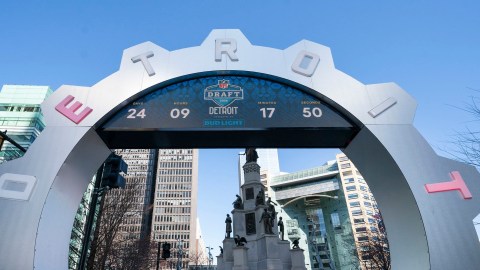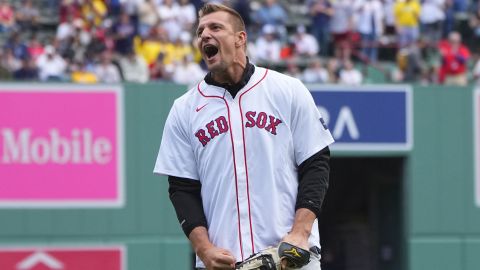Bill Belichick has presided over 20 NFL drafts during this time as head coach and de facto general manager of the New England Patriots. Over the next three weeks, we’re ranking each one of them.
Without further ado, here are our totally subjective and highly unscientific power rankings of each Patriots draft class from 2000 to 2018. (Note: It’s too early to properly judge the 2019 draft, so that one wasn’t considered for this exercise.)
1. 2003
DT Ty Warren (first round, No. 13), S Eugene Wilson (second, No. 36), WR Bethel Johnson (second, No. 45), DT Dan Klecko (fourth, No. 117), CB Asante Samuel (fourth, No. 120), C Dan Koppen (fifth, No. 164), QB Kliff Kingsbury (sixth, No. 201), FB Spencer Nead (seventh, No. 234), LB Tully Banta-Cain (seventh, No. 239), DT Ethan Kelley (seventh, No. 243)
Best pick: Warren
One of the more underrated players of the Belichick era, Warren was a very good defensive lineman throughout the 2000s. He started 92 games from 2003 to 2009 and had his best year in 2006, tallying 84 tackles, 7 1/2 sacks, 13 QB hits and 11 tackles for loss. The Patriots traded up one spot to draft Warren using the first-round pick they acquired in the Drew Bledsoe trade.
Worst pick: Johnson
The speedy wideout wasn’t an out-and-out flop, but he played just three seasons in New England and four in the NFL.
Analysis: This was a tremendous haul for the Patriots.
Warren, Wilson, Samuel and Koppen all started on Super Bowl-winning teams, and even Banta-Cain became a starter late in his career, recording 10 sacks for New England in 2009. Johnson never became a true offensive weapon but was dangerous as a return man and scored an important receiving touchdown in the 2003 divisional round.
The highest pick who didn’t make some sort of positive impact was Kingsbury, who now is entering his second season as the Arizona Cardinals’ head coach.
2. 2010
CB Devin McCourty (first round, No. 27), TE Rob Gronkowski (second, No. 42), LB Jermaine Cunningham (second, No. 53), LB Brandon Spikes (second, No. 62), WR Taylor Price (third, No. 90), TE Aaron Hernandez (fourth, No. 113), P Zoltan Mesko (fifth, No. 150), C Ted Larsen (sixth, No. 205), OT Thomas Welch (seventh, No. 208), DE Brandon Deaderick (seventh, No. 247), DT Kade Weston (seventh, No. 248), QB Zac Robinson (seventh, No. 250)
Best pick: Gronkowski
In Belichick’s smartest draft trade, the Patriots moved up two spots in the second round to select the greatest tight end of all time. Gronkowski had twice as many touchdown receptions from Tom Brady than any other player during the quarterback’s Patriots tenure (78; Randy Moss was second with 39).
Worst pick: Price
Cunningham was a dud, too, but Price was a total non-factor, appearing in just four games for the Patriots and six in the NFL.
Analysis: After a dysfunctional 2009 season and a first-round playoff exit, New England landed a pair of future Patriots Hall of Famers with their top two 2010 draft picks. McCourty and Gronkowski played pivotal roles in the Patriots’ immediate resurgence, reaching five Super Bowls in their first nine seasons and winning three.
There were some definite misses in this 12-player class, but Spikes (four-year starter in New England) and Mesko (three years) were solid finds, and Hernandez looked like a superstar in the making before his life took a tragic turn. Deaderick also provided more value than your typical seventh-rounder, and Larsen, though he never played a game for the Patriots, remains in the league. He’s started 88 games for four teams.
3. 2000
G Adrian Klemm (second round, No. 46), RB J.R. Redmond (third, No. 76), OT Greg Randall (fourth, No. 127), TE Dave Stachelski (fifth, No. 141), DT Jeff Marriott (fifth, No. 161), DB Antwan Harris (sixth, No. 187), QB Tom Brady (sixth, No. 199), DE David Nugent (sixth, No. 201), LB Casey Tisdale (seventh, No. 226), FB Patrick Pass (seventh, No. 239)
Best pick: Brady
Duh.
Worst pick: Klemm
Klemm appeared in just 26 games over his four seasons with the Patriots and started just 10.
Analysis: Belichick’s first Patriots draft largely yielded bit players and nobodies, but the selection of one Thomas Edward Patrick Brady Jr. at No. 199 alone is enough to earn it a top-three spot on this list.
Of the non-Brady selections, Pass stuck around the NFL the longest. The fullback/kick returner (that’s a combo you don’t see anymore) played for the Patriots through the 2006 season, scoring a modest four career touchdowns.
Redmond is remembered for his clutch receptions against the Raiders and Rams in the 2001 playoffs. Harris played 52 games for the Patriots as a reserve safety and special teamer and returned a blocked field goal for a touchdown in the 2001 AFC Championship Game.
Randall was New England’s top right tackle in 2001, starting all 19 games during the franchise’s first championship run.
4. 2002
TE Daniel Graham (first round, No. 21), WR Deion Branch (second, No. 45), QB Rohan Davey (fourth, No. 117), DE Jarvis Green (fourth, No. 126), RB Antwoine Womack (seventh, No. 237), WR David Givens (seventh, No. 253)
Best pick: Branch
A top-five Belichick-era receiver, Branch led the Patriots in receiving yards in 2003 and 2005 and ranked second behind Wes Welker in 2010 — his first year back after a four-plus-year stint in Seattle — despite playing in just 11 games. Branch earned Super Bowl XXXIX MVP honors for his 11-catch, 133-yard performance (on 12 targets) against the Philadelphia Eagles and also had huge games Super Bowl XXXVIII (10-143-1) and the 2005 divisional round (8-153-0).
Worst pick: Davey
One of Tom Brady’s first backups attempted eight passes in his NFL career. Davey was a stud in Europe, though, winning World Bowl VII and earning NFL Europe MVP honors in 2004.
Analysis: From a hit percentage standpoint, it’s hard to beat 2002. Of these six players, only Davey and Womack failed to make a significant impact for New England.
Graham didn’t put up huge numbers, but he was the Patriots’ primary tight end for most of his five-year run with the team. Green was a valuable defensive end for eight seasons and was one of New England’s top pass rushers in 2006 (7 1/2 sacks, 10 QB hits) and 2007 (6 1/2 sacks, 14 QB hits).
Givens, selected with one of the final 10 picks in 2002 draft, caught touchdown passes in seven of his eight playoff appearances.
5. 2012
DE Chandler Jones (first round, No. 21), LB Dont’a Hightower (first, No. 25), S Tavon Wilson (second, No. 48), DE Jake Bequette (third, No. 90), S Nate Ebner (sixth, No. 197), CB Alfonzo Dennard (seventh, No. 224), WR Jeremy Ebert (seventh, No. 235)
Best pick: Hightower
An immediate starter as a rookie, Hightower eventually succeeded Jerod Mayo as the leader of the Patriots’ linebacking corps. He’s been voted to two Pro Bowls and has made massive defensive plays in each of New England’s last three Super Bowl wins, earning the nickname “Mr. February.”
Worst pick: Wilson
Bequette played just eight games in the NFL, but Wilson was the bigger disappointment for Patriots fans. The second-round pick hardly played outside of special teams after a promising rookie season (four interceptions, two fumble recoveries) and wasn’t retained after his rookie contract expired. Similar to 2009 second-rounder Darius Butler, Wilson was able to carve out a larger role after leaving New England, starting 39 games for the Detroit Lions over the last four seasons.
Analysis: This was one of just two times Belichick made two first-round picks, and he hit on both, with Jones and Hightower becoming superstars in the Patriots’ defense. The Patriots were aggressive in targeting them, too, trading up from 27th to 21st to draft Jones and 31st to 25th to nab Hightower.
In his 20 Patriots drafts, Belichick has traded up in the first round just four times: in 2012 for Jones and Hightower, in 2003 for defensive tackle Ty Warren (No. 14 to No. 13) and in 2002 for tight end Daniel Graham (No. 32 to No. 21).
Jones has been one of the NFL’s top edge rushers over the course of his career, landing a spot on the NFL’s 2010s All-Decade Team. He’s operated in relative obscurity since New England traded him to Arizona in 2016, but he’s escalated his production since the move, tallying 11, 17, 13 and 19 sacks in his four seasons with the Cardinals.
Further down the board, the Patriots found one of the NFL’s top special teamers in Ebner — a non-combine invite who played just two years of college football — in the sixth round. Dennard started 20 of the 29 games he played in for New England, intercepting five passes, but was cut between his third and fourth seasons and never played another down in the NFL.
Ebert, one of five receivers the Patriots have drafted in the seventh round under Belichick, had a brief pro career, appearing in five games for the Jacksonville Jaguars in 2013.
6. 2001
DL Richard Seymour (first round, No. 6), OT Matt Light (second, No. 48), CB Brock Williams (third, No. 86), OT Kenyatta Jones (fourth, No. 96), TE Jabari Holloway (fourth, No. 119), LB Hakim Akbar (fifth, No. 163), TE Arther Love (sixth, No. 180), CB Leonard Myers (sixth, No. 200), K Owen Pochman (seventh, No. 216), LB T.J. Turner (seventh, No. 239)
Best pick: Seymour
Belichick’s highest Patriots draft pick also happened to be one of his best. Seymour, a five-time Pro Bowler and three-time first-team All-Pro for New England, was one of the top defensive tackles of his era and could have a bust in Canton before long. He was a Pro Football Hall of Fame finalist in each of the last two years.
Worst pick: Williams
The Notre Dame product never played in a game for the Patriots and played just 12 in his NFL career.
Analysis: This was Belichick’s top-heaviest Patriots draft, with no one outside of the top two spending more than two seasons in New England. It’s hard to complain when those two are Seymour and Light, though — two cornerstones who played pivotal roles on the franchise’s first three championship teams.
Light, the Patriots’ starting left tackle for all of his 11 NFL seasons, was inducted into the Patriots Hall of Fame two years ago. Seymour eventually will break through the Hall’s one-inductee-per-year logjam, as well. He’s lost out to Raymond Clayborn, Light and Rodney Harrison in the last three cycles.
7. 2009
S Patrick Chung (second round, No. 34), DT Ron Brace (second, No. 40), CB Darius Butler (second, No. 41), OT Sebastian Vollmer (second, No. 58), WR Brandon Tate (third, No. 83), LB Tyrone McKenzie (third, No. 97), G Rich Ohrnberger (fourth, No. 123), OT George Bussey (fifth, No. 170), LS Jake Ingram (sixth, No. 198), DT Myron Pryor (sixth, No. 207), WR Julian Edelman (seventh, No. 232), DT Darryl Richard (seventh, No. 234)
Best pick: Edelman
The second-best late-round find of Belichick’s tenure, behind only Tom Brady.
Worst pick: Brace
The Patriots traded second-, third- and sixth-round picks to move up seven spots to draft Brace, who started seven games over four seasons and was cut before the end of his rookie contract.
Analysis: There were some definite misses in this bunch, but Chung, Vollmer and Edelman is a dynamite trio, even if Chung didn’t hit his stride until his second Patriots stint. All three played key roles on the 2014 championship team, and they’ve combined to start a total of 276 games for New England.
Butler and Tate can’t be considered hits since they didn’t work out in Foxboro, but both enjoyed solid NFL careers. The former had a nice run in Indianapolis, and the latter became a productive return man for Cincinnati and Buffalo.
The Patriots only found one player of note in the back half of this draft, but the overwhelming success of Edelman more than offset the misses on players like McKenzie (zero appearances for New England), Ohrnberger (five) and Bussey (zero).
The sequence of trades that ultimately yielded Edelman was a fun one to retrace. The Patriots initially dealt their first-round pick (No. 23 overall) to Baltimore for pick No. 26 and a fifth-rounder. They then flipped both of those picks to Green Bay — which promptly selected future All-Pro linebacker Clay Matthews — for a second (used to draft Butler) and two thirds.
New England used one of those on Tate and traded the other to Jacksonville for a seventh-rounder and a 2010 second. The seventh turned into Edelman. The second became the key piece in the trade that produced Rob Gronkowski.
8. 2005
G Logan Mankins (first round, No. 32), CB Ellis Hobbs (third, No. 84), OT Nick Kaczur (third, No. 100), S James Sanders (fourth, No. 133), LB Ryan Claridge (fifth, No. 170), QB Matt Cassel (seventh, No. 230), TE Andy Stokes (seventh, No. 255)
Best pick: Mankins
The unluckiest Patriots great of the Belichick era, Mankins arrived in New England in 2005 and was traded just before the 2014 season, somehow missing out on all six of the franchise’s Super Bowl championships. He was voted to six Pro Bowls during that span and later earned a spot on the NFL’s All-Decade Team for the 2010s.
Worst pick: Claridge
You need to dig deep to find the first true miss of this class. Claridge, a fifth-round compensatory pick, never played a down in the NFL.
Analysis: Despite picking at the end of the first round and making just one of the first 83 selections, the Patriots were able to follow up their second straight Super Bowl title with a solid draft haul.
Hobbs, Kaczur and Sanders never reached Mankins’ heights, but all were multi-year starters for New England. Cassel went 11-5 in place of an injured Tom Brady in 2008, made a Pro Bowl with the Kansas City Chiefs two years later and stuck around the league as a backup until 2018.
The fact none of these players won a Super Bowl prevents the 2005 class from climbing higher in our rankings, but from a hit percentage perspective, this one is hard to beat.
9. 2011
OT Nate Solder (first round, No. 17), CB Ras-I Dowling (second, No. 33), RB Shane Vereen (second, No. 56), RB Stevan Ridley (third, No. 73), QB Ryan Mallett (third, No. 74), OT Marcus Cannon (fifth, No. 138), TE Lee Smith (fifth, No. 159), LB Markell Carter (sixth, No. 194), DB Malcolm Williams (seventh, No. 219)
Best pick: Solder
Landing Solder in this draft put in place a perfect succession plan from longtime left tackle Matt Light, who retired one year later. Solder was New England’s starting left tackle for six seasons, winning two Super Bowls before leaving to sign with the New York Giants on the most lucrative contract ever for an offensive lineman (four years, $62 million).
Honorable mentions go to Vereen, who bridged the gap between Kevin Faulk and James White, and Cannon, who started slow but has been the Patriots’ starting right tackle for the last four seasons, picking up one second-team All-Pro nod along the way.
Worst pick: Dowling
Ask any Patriots fan to name the biggest draft busts of the Belichick era, and Dowling will, without fail, be one of the first names mentioned. Taken with the first pick of the second round, the Virginia product appeared in just nine games for the Patriots and 12 in his pro career.
Analysis: Dowling was an all-time whiff, and the wildly disappointing Mallett made the Patriots regret straying from their typical quarterback prototype. Other than those two, though, this was a solid group.
Solder and Cannon became O-line cornerstones — though the latter took longer to get there — and Vereen and Ridley featured prominently in backfields that also featured LeGarrette Blount, Danny Woodhead and BenJarvus Green-Ellis. Vereen was a quiet standout in Super Bowl XLIX, catching a game-high 11 passes on 12 targets in New England’s dramatic win over the Seattle Seahawks.
Even Smith, who never played in a game for the Patriots, has enjoyed a long NFL career. He’s still in the league, appearing in all 16 games for the Buffalo Bills last season.
One trade Belichick made during this draft also laid the groundwork for future success. He traded the second of New England’s two first-round picks to the New Orleans Saints for a second-rounder (Vereen) and a 2012 first, which the Patriots used to draft future All-Pro edge rusher Chandler Jones.
10. 2015
Picks: DT Malcom Brown (first round, No. 32), S Jordan Richards (second, No. 64), DE Geneo Grissom (third, No. 97), DE Trey Flowers (fourth, No. 101), G Tre’ Jackson (fourth, No. 111), G Shaq Mason (fourth, No. 131), LS Joe Cardona (fifth, No. 166), LB Matthew Wells (sixth, No. 178), TE A.J. Derby (sixth, No. 202), CB Darryl Roberts (seventh, No. 247), LB Xzavier Dickson (seventh, No. 253)
Best pick: Flowers
A steal in the fourth round, Flowers led the Patriots in sacks in 2016, 2017 and 2018. New England reached the Super Bowl in all three of those seasons and won it all in ’16 and ’18.
Worst pick: Richards
Pre-draft scouting reports pegged Richards as a sixth- or seventh-round pick. Belichick took him in the second round. We all know how that turned out. Lacking the necessary fluidity to play defensive back and the size to play linebacker, Richards was a fine special teams player but struggled mightily on defense throughout his three seasons in New England, most notably in Super Bowl LII. If fans were asked to rank their least favorite player from Phase 2 of the Patriots dynasty, Richards probably would top the list.
Analysis: This draft didn’t feature a slam-dunk first-rounder (Brown was a starter in each of his four Patriots seasons, but the team declined his fifth-year option and let him walk in free agency) but Flowers and Mason were two of Belichick’s shrewdest mid-round selections. Mason and 2016 third-rounder Joe Thuney blossomed into one of the NFL’s better guard duos, though the former had a down year in 2019.
Cardona was a classic Belichick pick — who else drafts a long snapper in the fifth round? — but he hasn’t missed a game since entering the league while juggling his duties as a lieutenant in the Naval Reserves.
The rest failed to make a measurable impact in New England, with Grissom never graduating above special teams, Jackson lasting just one season and Wells and Dickson never appearing in a regular-season NFL game. Derby had a decent stretch with the Denver Broncos in 2016 and ’17 but now is out of the league.
Of that group, Roberts has enjoyed the most successful post-Patriots career, starting 26 games and notching 27 passes defended over four seasons with the New York Jets. He’s now in Detroit, one of the myriad New England alums to reunite with Lions coach Matt Patricia.
11. 2004
NT Vince Wilfork (first round, No. 21), TE Ben Watson (first, No. 32), DE Marquise Hill (second, No. 63), S Guss Scott (third, No. 95), S Dexter Reid (fourth, No. 113), RB Cedric Cobbs (fourth, No. 128), WR P.K. Sam (fifth, No. 164), CB Christian Morton (seventh, No. 233)
Best pick: Wilfork
Big Vince will be in the Patriots Hall of Fame one day and has an outside chance of landing in Canton. He’s on the Mount Rushmore of Belichick-era defensive studs.
Worst pick: Scott
This draft was a parade of disappointments after Watson. Scott appeared in just six games before being cut in 2006.
Analysis: Wilfork, selected with a pick acquired from the Baltimore Ravens the previous year, obviously was a home run, and Watson played a whopping 16 NFL seasons, seven of them with the Patriots.
New England got next to nothing out of the rest of this class, though, with its six other draftees combining for just 37 Patriots appearances. Hill, the only member of that group to stick around through the 2006 seasons, died in a jet ski accident in May 2017.
The Patriots did not execute a single trade during the 2004 draft — the only time that’s happened since Belichick took over — but they did swing a shrewd one a few weeks before the draft began. In mid-April, they sent a second-round pick to the Cincinnati Bengals for Corey Dillon, who immediately helped them win their second straight Super Bowl.
12. 2013
Picks: LB Jamie Collins (second round, No. 52), WR Aaron Dobson (second, No. 59), CB Logan Ryan (third, No. 83), S Duron Harmon (third, No. 91), WR Josh Boyce (fourth, No. 102), DE Michael Buchanan (seventh, No. 226), LB Steve Beauharnais (seventh, No. 235)
Best pick: Collins
Finding a player with Collins’ rare talent and athleticism in the latter half of the second round was a steal. Honorable mention here goes to Harmon, who was viewed as a major reach at the time but went on to play a key role in New England’s secondary for six seasons.
Worst pick: Dobson
Another draft bust at the receiver position, Dobson at least put together one promising season (37 catches, 519 yards, four touchdowns as a rookie) before coming undone. That’s more than Chad Jackson or Taylor Price could say.
Analysis: The Patriots made four picks in the first three rounds and hit on three of them, with Collins, Ryan and Harmon all became starters or pseudo-starters on Super Bowl winners.
Collins’ initial stint in New England — which included a Pro Bowl selection and a second-team All-Pro nod — ended inauspiciously, but he became a key cog in the NFL’s best defense upon his return last season. He’s now in Detroit along with Harmon, who intercepted more passes than any Patriots player (17) over the course of his tenure before being traded to the Lions last month.
The Patriots acquired the picks they used to draft Collins and Ryan by trading the 29th overall selection to the Minnesota Vikings, who coveted eventual Patriot Cordarrelle Patterson. New England swung another smart deal later in the draft, shipping a seventh-round pick and ex-track star Jeff Demps to Tampa Bay for LeGarrette Blount.
Buchanan and Beauharnais were seventh-round fliers, but Boyce was a disappointment in the fourth. He caught nine passes as a rookie and then played in just one game the rest of his career.
13. 2014
DT Dominique Easley (first round, No. 29), QB Jimmy Garoppolo (second, No. 62), C Bryan Stork (fourth, No. 105), RB James White (fourth, No. 130), OT Cameron Fleming (fourth, No. 140), OL Jon Halapio (sixth, No. 179), DE Zach Moore (sixth, No. 198), CB Jemea Thomas (seventh, No. 206), WR Jeremy Gallon (seventh, No. 244)
Best pick: White
Maybe the best middle-rounds pick of the Belichick era. White’s impact in the final four years of Tom Brady’s tenure — most notably in Super Bowl LI — cannot be understated.
Worst pick: Easley
Arguably Belichick’s biggest draft whiff. Easley was cut after just two seasons, both of which ended with him on injured reserve.
Analysis: Honestly, this draft probably should be lower on the list for the Easley pick alone.
Belichick has a spotty drafting record in the second round, but his first-rounders tend to be, at the very least, moderately productive for several seasons. Here’s the full list of players New England has selected in the first round since 2000:
N’Keal Harry
Isaiah Wynn
Sony Michel
Malcom Brown
Dominique Easley
Chandler Jones
Dont’a Hightower
Nate Solder
Devin McCourty
Jerod Mayo
Brandon Meriweather
Laurence Maroney
Logan Mankins
Vince Wilfork
Ty Warren
Daniel Graham
Richard Seymour
Excluding Harry, Wynn and Michel, whose careers still are young, every one of those players but Easley played at least four seasons in New England and were multi-year starters. Even Maroney, who never lived up to his draft slot, led the Patriots in rushing twice. Easley was the only flat-out flop.
The Patriots followed it up with a few hits, though.
Garoppolo would have replaced Brady had the latter not blown past the typical expiration date for quarterbacks. Concussions and David Andrews’ emergence abbreviated Stork’s career, but he was the starting center for a Super Bowl winner as a rookie. White is either the best or the second-best third-down back of the Belichick era, depending on whether you prefer Kevin Faulk. Fleming was a solid backup and occasional starter for four seasons.
Halapio, Moore, Thomas and Gallon never played in a game for New England. Halapio made 15 starts for the New York Giants last season.
14. 2008
LB Jerod Mayo (first round, No. 10), CB Terrence Wheatley (second No. 62), LB Shawn Crable (third, No. 78), QB Kevin O’Connell (third, No. 94), CB Jonathan Wilhite (fourth, No. 129), WR Matthew Slater (fifth, No. 153), LB Bo Rudd (sixth, No. 197)
Best pick: Slater
Mayo was a slam dunk at No. 10 overall, but Slater has become both arguably the greatest special teams player in NFL history and one of the most important leadership figures of the Belichick era. Identifying a player like that in the fifth round was a classic Patriots move.
Worst pick: Wheatley
The first in a long line of second-round defensive backs who flamed out in New England, Wheatley appeared in just 11 games for the Patriots and 12 total in his career.
Analysis: Any draft that produces two multi-year Pro Bowlers who also become longtime team captains is a solid haul. But imagine if the Patriots had hit on even one of their picks in Rounds 2 through 4.
Wheatley, as mentioned, was a bust. Crable’s career featured just six regular-season appearances, and those didn’t come until 2010, his third and final Patriots season. O’Connell can’t be knocked for not beating out Tom Brady, but the Patriots cut the QB after a single season, and he never saw game action again. Wilhite at least made some sort of impact, starting 13 games over three seasons and nabbing three interceptions. He was released in 2011, though, and was out of the league a year later.
The Patriots also were forced to forfeit their own first-round selection in this draft (No. 31) as part of their Spygate punishment. They were able to land Mayo thanks to a trade they made with the San Francisco 49ers the previous year (see item 18 below).
Mayo, who’s now the Patriots’ inside linebackers coach, is the only player New England has drafted in the top 10 since it won its first Super Bowl in 2001.
15. 2018
OT Isaiah Wynn (first round, No. 23), RB Sony Michel (first, No. 31), CB Duke Dawson (second, No. 56), LB Ja’Whaun Bentley (fifth, No. 143), LB Christian Sam (sixth, No. 178), WR Braxton Berrios (sixth, No. 210), QB Danny Etling (seventh, No. 219), CB Keion Crossen (seventh, No. 243), TE Ryan Izzo (seventh, No. 250)
Best pick: Wynn
Wynn has shown the ability to be a franchise left tackle when healthy. But he’s also played in just eight games over his two pro seasons.
Worst pick: Dawson
Dawson has the unfortunate distinction of being the only first- or second-round draft pick of the Belichick era to never appear in a regular-season game for the Patriots.
Analysis: The legacy of this draft class will be written over the next two seasons.
If Wynn proves he can stay on the field, Michel returns to his 2018 form after an underwhelming 2019 and Bentley, a virtual unknown pre-draft, establishes himself as a true starting-caliber linebacker after being buried on the depth chart last season, it’ll look pretty darn good. But five of these nine selections lasted one season or less in New England, and the question marks that still surround their more promising picks prevent this group from earning a higher spot on our list.
The best move New England made during this draft was trading a third-round pick to San Francisco for Trent Brown, who went on to start every game at left tackle for the Super Bowl LIII champions, and the fifth-rounder it used to select Bentley.
Speaking of trades, the 2018 draft might be best remembered for Belichick’s splintering of the Jimmy Garoppolo return (a second-round pick, No. 43 overall), which ultimately yielded Sam, Damien Harris and shares of Dawson, Joejuan Williams, Yodny Cajuste, Jarrett Stidham and Byron Cowart, plus a fourth-rounder in this year’s draft.
Just realized there’s still one last remnant of the mind-numbingly convoluted Jimmy Garoppolo return floating around: the Patriots’ fourth-round pick this year (No. 125). pic.twitter.com/8DIhIaszl5
— Zack Cox (@ZackCoxNESN) April 5, 2020
Also worth noting: The Patriots drafted Michel one spot before 2019 NFL MVP Lamar Jackson and four spots ahead of another Georgia running back, Nick Chubb. Two years in, Chubb has 2,490 rushing yards to Michel’s 1,843 and has averaged 5.1 yards per carry (5.0 or better in each season) to Michel’s 4.0.
16. 2016
CB Cyrus Jones (second round, No. 60 overall), G Joe Thuney (third, No. 78), QB Jacoby Brissett (third, No. 91), DT Vincent Valentine (third, No. 96), WR Malcolm Mitchell (fourth, No. 112), LB Kamu Grugier-Hill (sixth, No. 208), LB Elandon Roberts (sixth, No. 214), G Ted Karras (sixth, No. 221), WR Devin Lucien (seventh, No. 225)
Best pick: Thuney
A starter from the day he arrived in Foxboro, Thuney has hardly missed a snap over the last four seasons, blossoming into one of the NFL’s top interior linemen. He earned second-team All-Pro honors last season and was expected to land a hefty contract in free agency before the Patriots franchised him. Barring a trade — which remains a possibility — Thuney will hold down New England’s left guard spot again this season.
Worst pick: Jones
Drafted more for his punt/kick return ability than his defensive prowess, Jones struggled in both facets during his tumultuous Patriots tenure. The Alabama product fumbled five times as a rookie, missed the entire 2017 season with a torn ACL, was released during final cuts in 2018 and then was cut again a month later following a brief return.
Second-round Patriots defensive backs have flopped at an alarmingly high rate of late, with Jones, Jordan Richards (2015) and Duke Dawson (2018) all flaming out. The jury’s still out on Joejuan Williams (2019), who hardly played as a rookie.
Analysis: Thuney was the only definitive stud to come out of this class. And four years later, he’s the only player still with the Patriots, though Roberts and Karras both provided solid value relative to their draft slots before departing in free agency last month.
Brissett, never a true contender to succeed Tom Brady, was traded to Indianapolis after one season. Valentine showed some promise as a rookie but missed all of 2017 with a knee injury and now is out of the league. The Patriots probably wish they’d kept Grugier-Hill, who became a core special teamer and team captain for Philadelphia after failing to crack New England’s roster as a rookie.
The biggest “what if?” in this group is Mitchell. He had one of the best rookie seasons by any Patriots receiver in the Bill Belichick era and was instrumental in the team’s Super Bowl LI comeback (five catches, 63 yards in the second half and overtime) but never played another game, his career cut short due to chronic knee issues.
17. 2006
RB Laurence Maroney (first round, No. 21), WR Chad Jackson (second, No. 36), TE David Thomas (third, No. 86), FB Garrett Mills (fourth, No. 106), K Stephen Gostkowski (fourth, No. 118), OT Ryan O’Callaghan (fifth, No. 136), DE Jeremy Mincey (sixth, No. 191), G Dan Stevenson (sixth, No. 205), DT Le Kevin Smith (sixth, No. 206), CB Willie Andrews (seventh, No. 229)
Best pick: Gostkowski
Adam Vinatieri’s replacement held his job for 14 seasons before finally being released last month. Finding Gostkowski’s successor should be high on the Patriots’ list of offseason priorities.
Worst pick: Jackson
One of the poster boys for Patriots draft busts, Jackson lasted just two injury-plagued seasons in New England, catching a grand total of 13 passes over 14 appearances. Belichick, who actually traded up to draft Jackson, traditionally has struggled to draft quality receivers, with Jackson, Taylor Price (third round, 2010) and Aaron Dobson (second round, 2013) standing out as his most glaring whiffs.
Analysis: Finding one of the best kickers in NFL history was the saving grace for this otherwise ugly draft class.
Maroney never lived up to his draft slot. Thomas’ two best seasons came after he left New England. Mills, Mincey and Stevenson never played a game for the Patriots, though Mincey went on to have some solid years in Jacksonville and Dallas. O’Callaghan, Smith and Andrews stuck around as depth guys for a bit, but their impacts were minimal.
Of the 14 players drafted between Maroney and Jackson, eight became Pro Bowlers, and two others — Santonio Holmes and Mathias Kiwanuka — went on to play key roles on Super Bowl winners.
18. 2007
S Brandon Meriweather (first round, No. 24 overall), DT Kareem Brown (fourth, No. 127), OT Clint Oldenburg (fifth, No. 171), LB Justin Rodgers (sixth, No. 180), CB Mike Richardson (sixth, No. 202), RB Justise Hairston (sixth, No. 208), OT Corey Hilliard (sixth, No. 209), LB Oscar Lua (seventh, No. 211), G Mike Elgin (seventh, No. 247)
Best pick: Meriweather
Meriweather was a bit of a loose cannon and was cut before the end of his rookie contract, but he grabbed 12 interceptions, made two Pro Bowls and never missed a game over his four seasons in New England.
Worst pick: Brown
Career regular-season appearances for Meriweather’s former Miami teammate: one.
Analysis: New England took just one of the first 126 picks in 2007, and it showed. Meriweather was the only solid pro to come out of this class. Of the others, only Richardson ever appeared in a game for the Patriots, and his 10 appearances didn’t come until the 2008 season.
Of course, this lack of rookie impact didn’t hinder the ’07 Pats, who won their first 18 games before falling to the New York Giants in Super Bowl XLVI. And one trade they executed during this draft helped shape their team for years to come.
New England traded the second of its two first-round selections to the San Francisco 49ers for a fourth-rounder and a 2008 first-rounder. The Niners used their pick (No. 28 overall) to draft Joe Staley. The Patriots flipped the fourth to Oakland for Randy Moss and used the first to move into position to select Jerod Mayo the following year.
19. 2017
DE Derek Rivers (third round, No. 83), OT Antonio Garcia (third, No. 85), DE Deatrich Wise (fourth, No. 131), OT Conor McDermott (sixth, No. 211)
Best pick: Wise
Wise has taken steps backward in each of the last two seasons following a promising rookie campaign.
Worst pick: Garcia
The Patriots actually traded up 11 spots to draft Garcia, who was cut a year later and has yet to appear in an NFL game. The Detroit Lions used the pick they received in that deal (No. 96) to draft Kenny Golladay, a 1,000-yard receiver in each of the last two seasons.
Analysis: This was by far Belichick’s smallest Patriots draft class, and if you include the players the team acquired in pre-draft trades (Brandin Cooks, Dwayne Allen) it doesn’t look quite so terrible. But in terms of actual picks, this was a meager haul.
Rivers, drafted one spot ahead of Chris Godwin and three ahead of Kareem Hunt, missed the entire 2017 and 2019 season with injuries and hardly played in 2018. Wise had more roughing the passer penalties (three) than sacks (two) last season. McDermott failed to make the roster as a rookie. The Patriots also traded a late fifth-round pick for tight end James O’Shaughnessy and a late sixth-rounder, then cut O’Shaughnessy that summer.
It’s tough to draft studs when you don’t pick until the latter half of the third round — and New England’s forfeiture of its own fourth-round selection over Deflategate didn’t help matters — but the Patriots have found plenty of gems in the middle rounds over the years. Their whiffs there in ’17 make this the weakest draft class of the Belichick era.
